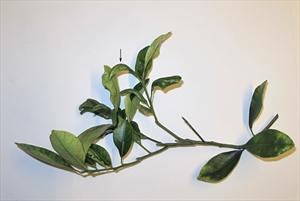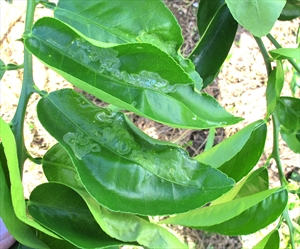- Worldwide distribution. In the tropics and sub-tropics. Most commonly on members of the citrus family, e.g., cumquat, grapefruit, lime, and sour orange. An important pest.
- A moth larvae damages new shoots of trees; worse in nurseries and on young trees.
- Eggs laid singly near midribs of young leaves; larvae hatch, mine the surface layers causing leaves to distort. Mines fill with air and look silvery; and they have a central line of excreta.
- Natural enemies: parasitoid wasps.
- Cultural control: prune damage on nursery plants and young field trees, and collect and burn the prunings.
- Chemical control: leafminer worse where pesticides are used against other insects (e.g., Diaphorina that spreads citrus greening or huanglongbing disease). Use pest oils at start of main flush when shoots are 20-30cm long.
Pacific Pests, Pathogens and Weeds - Online edition
Pacific Pests, Pathogens, Weeds & Pesticides
Citrus leafminer (240)
Citrus leafminer
Phyllocnistis citrella
AUTHOR Grahame Jackson
Information from Waterhouse DF (1998) Biological Control of Insect Pests: Southeast Asian Prospects. ACIAR Monograph No. 51, 548 pp. Brown Prior Anderson, Melbourne; and Grafton-Cardwell EE et al. Citrus leafminer (undated). University of California Statewide IPM Program. Agriculture and Natural Resources, University of California. (http://ipm.ucanr.edu/PMG/PESTNOTES/pn74137.html); and from Citrus leafminer (2020) Agriculture and Food. Department of Primary Industries and Regional Development. Government of Western Australia. (https://www.agric.wa.gov.au/citrus/citrus-leafminer?page=0%2C1).
Produced with support from the Australian Centre for International Agricultural Research under project PC/2010/090: Strengthening integrated crop management research in the Pacific Islands in support of sustainable intensification of high-value crop production, implemented by the University of Queensland and the Secretariat of the Pacific Community.











